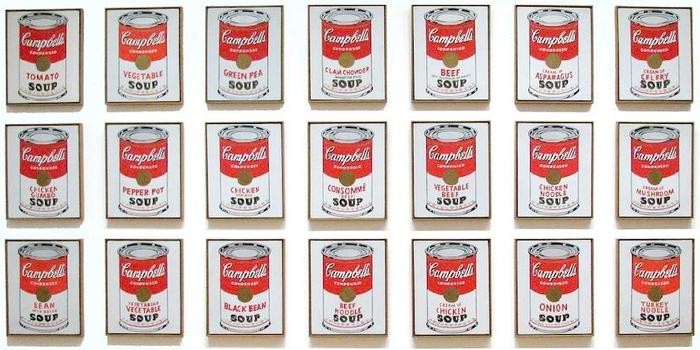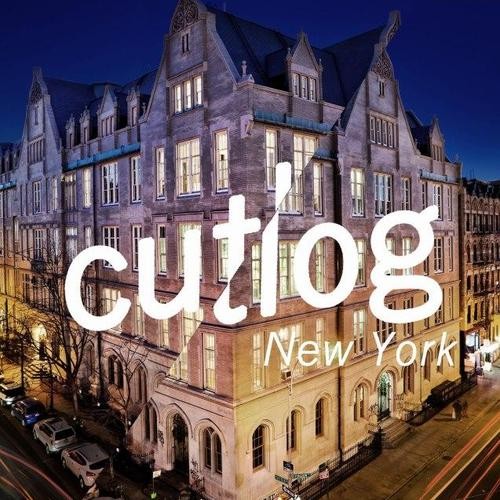Quite possibly the most revolutionary artist since Marcel Duchamp, Andy Warhol radically altered art's relationship to notions of authorship and commodity and blurred the boundaries between perfomance, photography, painting, and sculpture. Warhol’s innovations, which have now become familiar artistic techniques, confounded traditional notions of what an artist did—Warhol, for instance, outsourced much of his work to assistants, a mode of working not commonly seen since the time of the Old Masters—and what artistic subject matter could be.
Using reproductions of commonplace images available from advertising and the celebrity press, Warhol presented art as one commodity among many and the artistic process as an act filled with equal parts indifferent boredom, ingenious marketing, and celebration. He was lauded as a mirror of contemporary American culture, in which, he predicted, everyone would experience (or want to experience), “15 minutes of fame,” to use a phrase he coined. Pop art, after all, derives its name from "popular," and in Warhol's work every aspect of that word resonates, from the phenomenon of fame to the levelling of American democracy.
Warhol had many artistic pursuits, ranging from music (he helped form and promote the Velvet Underground) and performance to painting, prints, sculpture, and film. However, his best-known works are perhaps his photographic serigraphs, characterized by their brilliant (and unnatural) silk-screened colors, hand-drawn outlines, and ubiquitous mass-media images, such as portraits of pop-culture stars and consumer goods.
The actor Dennis Hopper, an avid collector and friend of the artist, once described the foresight Warhol and his peers had in re-introducing figurative and representational elements to the visual arts given the dominance of abstraction since the beginning of the 20th century, saying, “[The Pop artists] were coming back to reality… This was the return to reality.” Here's an introduction to several of his key series and themes.
SOUP CANS (AND OTHER CONSUMER GOODS)
Warhol began his career as a successful commercial illustrator—he made ink designs for Harper's Bazaar and window displays for the Bonwit Teller department store, for instance—and used this experience as the foundation for his early work. Warhol’s first screen prints, such as his Campbell Soup cans, were directly modeled on advertising imagery, reflecting the increasingly mediated reality in which Americans were living. The images were reproduced virtually unaltered, a key innovation by Warhol that seemed to disavowed the notion of artistic skill, but in fact shifted the demonstration of that skill into graphic and conceptual expression.
Warhol continued this tactic into the realm of sculpture, making life-size replicas of Brillo Boxes that so stunned the philosopher Arthur Danto that he declared them to be the absolute conclusion of Western art history, fusing representation and the thing being represented so totally that it marked "the end of art." Warhol's own stated outlook was less dramatic: he painted what he liked. As for Campbell's Soup, he ate it for lunch every day for 20 years.
ADVERTISEMENTS
Later in his career, Warhol received commissions for advertising campaigns and happily traded on his artistic credibility to sell prestigious wares. Warhol’s 1984 screen print La Grande Passion, made for a brand of fruit-flavored liqueur, turned his advertisement-based artworks into artwork-based advertisements. Warhol likely saw little in that distinction: he referred to himself simply as a “commercial artist” in every possible sense of the term. "Being good in business is the most fascinating kind of art," he famously said. "Making money is art and working is art and good business is the best art."
MARILYN MONROE
Along with the Campbell's soup cans, Warhol's paintings of this star are the most iconic works of his career. The story behind the Marilyns (as they are called), however, is darker: he made his most famous depictions of the actress after her tragic death in 1962. As a result, the portraits stand not only as celebrations of American pop culture and fame but also intimations of their dark side—taken together they are a mementi mori.
Monroe’s rosy but troubled visage was mined and repeated by Warhol for several years, and traces of her can be found in other works: I Love Your Kiss Forever Forever (1964) uses a picture of Monroe’s lips, reproduced six times across a two-page magazine spread, accompanied by text. The felicitous smile is instantly recognizable, seared into cultural memory through their endless repetitions in the media.
Warhol’s early depictions of celebrities included major film stars of the era, their images taken from Hollywood tabloids. He was particularly drawn to beautiful actresses—like Elizabeth Taylor, Jane Fonda, and Liza Minnelli—whose tumultuous private lives had made them media sensations, giving their glamorous personae an undercurrent of the demimonde. But, fundamentally, Warhol’s celebrity images function in much the same way as his paintings of Campbell’s soup cans and Brillo boxes, suggesting that these figures and their iconic, media-circulated depictions are a form of consumer product to be exchanged.
WARHOL "CELEBRITIES"
Much of Warhol’s work addresses the nature of celebrity. Besides the portraits of famous personalities that he made during his career, Warhol also cultivated celebrities of his own. Those young artists and hangers-on around his studio, called the Factory, were dubbed “superstars” and promoted as such. They played in his movies, assisted in making his paintings, and served as surrogates in interviews, which often became more like cocktail-party chatter than journalistic Q&A sessions.
Quite quickly, Warhol was also approached for commissioned portraits for collectors and famous personalities who wanted the glamorous sheen of his Pop style. He produced them with varying degrees of earnestness and aloofness. Some portraits were produced in photo booths; others were made using a variety of cameras, especially Polaroids. The resulting high-contrast images often render their subjects as focused, enigmatic, and brazen. Over several decades, Warhol experimented with a number of styles used to reproduce the images as prints. Later in his career, Warhol would add loose gestural outlines and exotic, frenetic color combinations, exemplified by his portrait of the philanthropist Mildred Scheel.
SPORTS ICONS
Continuing Warhol's keen-eyed obsession with celebrity, the artist's "Athletes" series captured the most prominent sports stars of the day, from Mohammad Ali to Wayne Gretzky. Notably, Warhol once again captures the zeitgeist in these works, which were commissioned by the collector Richard Weisman in 1977—just at the time when the explosion of TV sports broadcasts and advertising sponsorships were making athletes into celebrities on par with Hollywood's leading men and women. While the artist was not a sports fan himself, per se, he cannily adapted his visual idiom to appeal to fans: the colors of his 1984 portrait of Wayne Gretzky plays off the team colors of the New York Rangers hockey team, of which Gretzky was a star player.
FLOWERS
More conceptually thorny than sweet, Warhol's Flowers are an instance both of the artist's brilliant graphic sensibility and his boundary-crossing conceptual audacity. Inspired by the influential Metropolitan Museum of Art contemporary art curator Henry Geldzahler to paint flowers, Warhol came across a photo spread in Modern Photography magazine featuring images of hibiscus flowers printed in a variety of colors that editor Patricia Caulfield had taken to illustrate the way different chemical processes would produce varied colors. Warhol manipulated the photo to group four of the flowers in an elegant square and produced a series of multicolored versions that he used to fill his legendary first show at Castelli Gallery. The paintings inspired comparisons to Matisse—and also a lawsuit from Caulfield, which the artist settled out of court.
DEATH AND DISASTER
In his interview with the filmmaker Emile de Antonio for the 1973 documentary Painters Painting, Warhol is cagey on the subject of his 1971 Electric Chair, benignly describing it as an “old image” made intriguing by New York State’s recent moratorium on capital punishment. But the work is far more complex, part of Warhol's infamous "Death and Disaster" series depicting newspaper images of car crashes, fatal food poisonings, suicides, race riots, and other dark subjects. The result is some of the more forceful imagery in his oeuvre, remarkable not only for their morbidity but also the way they render these awful scenarios as utterly banal. "When you see a gruesome picture over and over again," Warhol once said, "it doesn't really have the same effect." The twisted drama contained in these works pushed one of them, Green Car Crash (1963), to sell for an artist-record $71.7 million at Christie's in 2007.
MAO
AMERICAN POLITICS
One of the only expressly political images Warhol made, Vote McGovern (1972), features an image of then President Richard Nixon, his face a sickly turquoise green, orange lips, and fiery, devilish suit, eyes, and background. The image directs itself fully and vehemently against Nixon much more than it says anything about the pacifist, anti-poverty Democratic candidate George McGovern, whom it was intended to support. Warhol made a number of other portraits of Democratic candidates for president, including Jimmy Carter in 1976 and Ted Kennedy (during his failed primary challenge against Carter) in 1980. But unlike subsequent artworks for political figures, such as Shepherd Fairey’s 2008 poster for Barack Obama, Warhol’s images are much more interested in celebrity (whether entertainment or political) as streams in the ebb and flow of vernacular visual culture.
COWBOYS AND INDIANS
As a more acute example of his free hand, Warhol’s 1986 "Cowboys and Indians" series presents colorful, vibrant images of American-Indians from documentary photographs, a portrait of Theodore Roosevelt, John Wayne in a Stetson hat, buffalo nickels, and craftworks by indigenous peoples of the American West. In Warhol’s portfolio, the chronology, history, and details of frontier conquest are abstracted, leaving only courageous narratives and iconic images all treated with the same adoration.
RELIGION
A practicing, church-going Catholic all his life, Warhol turned toward the end of his life to creating overtly religious paintings, applying his graphic impulse and avant-garde techniques to reprising famous imagery from devotional artworks—culminating in his final series, a group of paintings that both lovingly retrace and aggressively deconstruct Leonardo's Last Supper. At Warhol's funeral service, the celebrated art historian John Richardson surprised many attendants by detailing the depth of the artist's religiosity. “To me Andy always seemed other worldly, almost priest-like," he said.



























